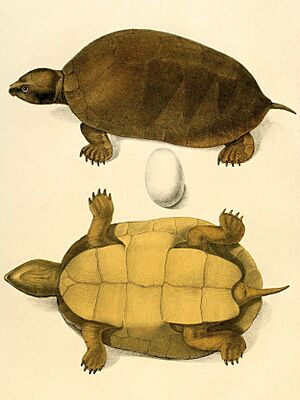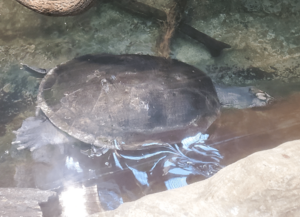Big-headed Amazon River turtle facts for kids
Quick facts for kids Peltocephalus dumerilianus |
|
|---|---|
 |
|
| Conservation status | |
| Scientific classification | |
| Genus: |
Peltocephalus
|
| Species: |
dumerilianus
|
The Big-headed Amazon River turtle (Peltocephalus dumerilianus) is a type of turtle found in the Amazon region. It is also known as the big-headed sideneck because of how its head is shaped and how it pulls its head into its shell. This turtle belongs to the family Podocnemididae.
Contents
About the Big-headed Amazon River Turtle
This turtle is named dumerilianus to honor a French expert on reptiles and amphibians named André Marie Constant Duméril. It is a very old type of turtle, with its group splitting off from other turtles about 86 million years ago. An even bigger type of Peltocephalus turtle, called Peltocephalus maturin, used to live a long time ago but is now extinct.
What Does It Look Like?
The Big-headed Amazon River turtle can grow quite large. The biggest one ever measured had a shell about 50 cm (1.6 ft) long and weighed around 15 kg (33 lb). There are stories of even larger ones!
Like many turtles, males and females look a bit different. This is called Sexual dimorphism. Male turtles are usually bigger and have wider heads and longer tails than females. This turtle looks a lot like the Madagascan big-headed turtle. Both of these turtles eat a mix of plants and animals, unlike some other turtles that only eat plants.
Where Does It Live?
You can find the Big-headed Amazon River turtle in several countries in South America. These include Brazil (in areas like Amazonas and Pará), Colombia, French Guiana, Venezuela, Ecuador, and possibly Peru.
What Kind of Home Does It Like?
These turtles love living in rivers and freshwater swamps. They especially like "blackwater" rivers, which get their dark color from decaying plants. These areas are often flooded forests, providing good hiding spots.
How Does It Behave?
Big-headed Amazon River turtles have very strong jaws. They can bite with a lot of force, which helps them eat their food. Even young turtles have strong bites. While they don't usually fight over territory, captive turtles can be aggressive towards other turtle species.
They are not the fastest swimmers compared to some other turtles. They also tend to stay in the same area for a long time. One male turtle was found in the same stream where it was first tagged as a baby, 19 years later!
What Does It Eat?
The Big-headed Amazon River turtle is an omnivore, meaning it eats both plants and animals. It eats more animal matter than other turtles in its family. However, fruits and seeds can still make up a large part of its diet, sometimes as much as 85%! They especially like to eat apple snails when they can find them.
Since they eat seeds and those seeds sometimes pass through their bodies undigested, these turtles might help spread seeds around, which is important for plants. They are also opportunistic hunters. This means they will eat whatever they can find. They often crawl along the bottom of rivers looking for snails, fish, insects, and even dead animals.
Sometimes, adult turtles have been seen sitting very still underwater with their mouths open. They might be waiting for prey to swim by, similar to how alligator snapping turtles hunt.
How Do They Reproduce?
Like all turtles, the Big-headed Amazon River turtle lays eggs. This is called Oviparity. Unlike some other turtles that lay their eggs on sandy beaches, these turtles prefer to build their nests in hidden places.
Conservation Status
The Big-headed Amazon River turtle is currently listed as a Vulnerable species by the IUCN. This means it is at risk of becoming endangered. However, this assessment was made in 1996, and the threats to the species might be even greater now.
Their homes are being damaged by pollution from mining and pesticides. Forests are being cut down, and new dams are being built, which changes their river habitats. Illegal gold mining also affects many of these turtles each year. They are also hunted for food in their native range. Long ago, explorer Alfred Russel Wallace noted that local people hunted these turtles and that they were becoming rarer even then. Protecting their habitats and reducing hunting are important steps to help these unique turtles survive.



